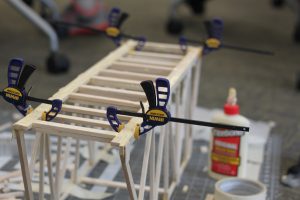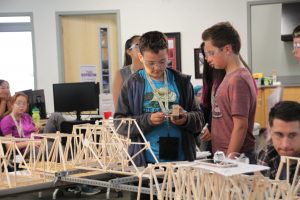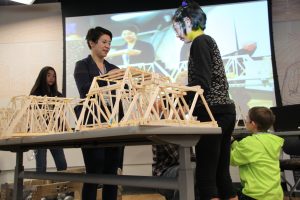A balsa wood bridge isn’t something you’d want to drive your car over, but it can be a useful way to expose kids to engineering.
The Alaska Native Science and Engineering Program recently hosted middle school students from the Anchorage School District at the University of Alaska Anchorage.
In a building on the edge of the UAA campus, 47 middle schoolers are putting last-minute touches on miniature bridges.

The students gather in groups around blueprints of their own design. They carefully measure, cut, and glue thin pieces of balsa wood, hoping their creations will be able to stand up to the abuse of real-world testing.
The bridge building exercise is part of the ANSEP program’s Middle School Academy. For two weeks, the students live on campus and get a taste of college life, while being exposed to careers in science, technology, engineering, and math.
“So they are getting that experience, they’re able to not only envision themselves here in the future, but actually spend some time here and prepare for their university experience in the future,” Josephine Mattison, ANSEP’s middle school director, said.
She says that other than a push in the right direction and some adult supervision, the students are left to their own devices when building their bridges.

“So it empowers them quite a bit and there is a bit of challenge in it as well as they have time constraints and working with others and getting all the kinks worked out in time to test,” Mattison said.
Among other things, the students took part in an earthquake engineering session and built computers that they would later use to design their bridges.
The students are selected through a process designed to prepare them for applying to college. They submit grades and test scores, complete an essay, and provide teacher references. If they’re chosen, they get to attend the program for free.

Nancy Neil teaches at Hanshew Middle School and this is her second year helping at the Middle School Academy. She describes the program as a pre-college bootcamp.
“We’re teaching them to be thinkers, we’re teaching them not just to learn out of a book,” Neil said. “They have to problem solve and we need more of that in education today.
She says that the bridge building exercise does more than just teach them about math and science.
“They might have a mind of an engineer, but they also need to know about how to get along with people and this whole bridge building is a challenge so it’s kind of hitting the best of both worlds,” Neil said.
A couple of days later, after the glue is dried and the bridges are complete, it’s time to put them to the test. Each group takes turns describing their process and how much weight they predict their bridge will hold.

The bridge is attached to a platform and a wooden tray is suspended from the center. Chaperones then slowly add fist-sized metal balls to the tray until the bridge slowly gives out or like some did, explode.
No one appeared heartbroken over their hard work being destroyed and most seemed to enjoy watching how their classmates did. One team set a Middle School Academy record for how much weight their bridge held.
While the adults look at this program as a means to get students thinking seriously about higher learning, most of the kids— like Jordan Kehl— are just looking for a good time.
“It’s just very interesting here and very fun, if you want to make new friends,” Kehl said.
He says the program also helps him avoid a younger sibling.
“There’s nothing better to do, because if you have a little sister at home, it gets hectic,” Kehl said.
The next round of students who will spend time on campus and get free time away from younger brothers and sisters, will be kids from school districts around the state.
Ammon Swenson is Alaska Public Media’s Audio Media Content Producer. He was born and raised in Anchorage, Alaska. He graduated from UAA in 2018 with a bachelor’s degree in journalism and integrated media. He’s previously worked for KRUA radio, the Anchorage Press, and The Northern Light.





